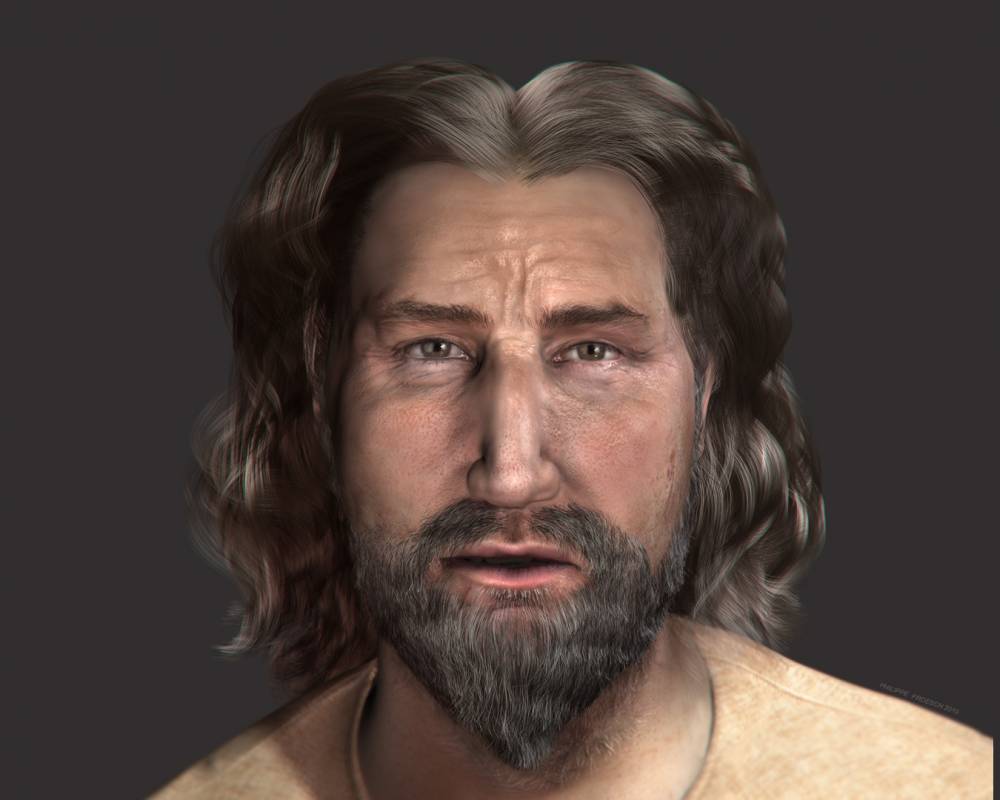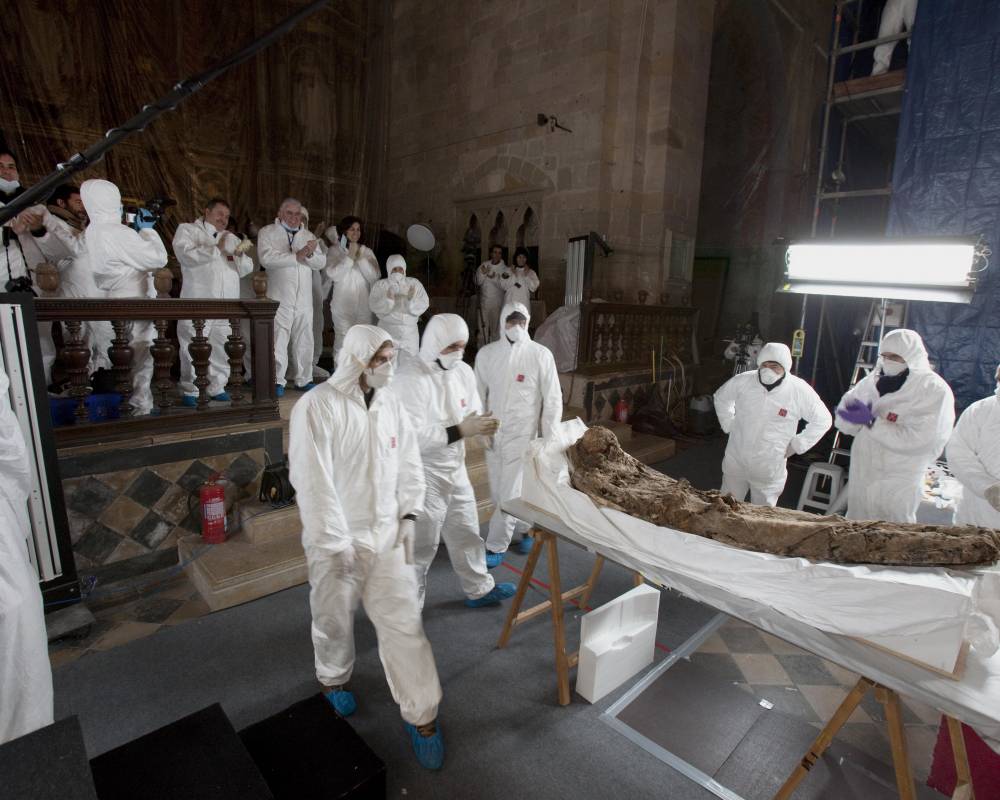
In 2010, on the 850th anniversary of the founding of the monastery of Santes Creus, work began on the restoration of the royal pavilion of Santes Creus and the scientific investigation of the tombs that form part of it.
El Museu d’Història de Catalunya (Catalonia History Museum) coordinated multidisciplinary teams (made up of historians, archaeologists, restorers, paleopathologists and physical anthropologists) to study the tombs of kings Peter II the Great, James II the Just and Queen Blanca d’Anjou, as well as that of Admiral Roger de Llúria. The study supplied valuable data on the life, illnesses and death of these personalities, as well as the dowry and funerary rites of the era.
The results of the study, which were made public in 2011, focused on the remains of Peter II –which were found intact – and of Blanca d’Anjou –in an excellently-preserved state–and established that the remains found in the tomb of Roger de Llúria were indeed those of the admiral.
The remains of the king on the mould just after being raised up. Photos: Carles Aymerich and Ramon Maroto (Centre for the Restoration of Works of Art in Catalonia Restauració de Béns Mobles de Catalunya) > Flickr Patrimoni.gencat

The tomb of one of the most noteworthy kings of the Crown of Aragon has remained intact over the course of 700 years; which is a record. The sepulchre of Peter II, nicknamed the Great, who has been buried in the Royal Monastery of Santes Creus since 1285, is one of the few tombs of a European royal line that has not been exhumed and the only tomb of a Catalan king which has not been plundered.
The mummified body of Peter II, which is outstanding and internationally relevant, was found in June 2010 during the restoration works on the tombs spurred by the Department of Culture and Media, under the instruction of the Museu d’Història de Catalunya.
This unique and unprecedented opportunity to find out unedited information about the king, royal burial rites in the 13th century and clothing of the era led to the mobilisation of a multidisciplinary team with a mission to exhume and study his human remains and the sepulchre in which they were contained.
"Royal Monastery of Santes Creus” – Photograph: Josep Giribet – Patrimoni.gencat
"3D Reconstruction of the Tomb of Peter II the Great – Museu d’Historia de Catalunya
"3D Side Section of the Tomb of Peter II the Great – Museu d’Historia de Catalunya
"Royal tomb of Peter the Great - Santes Creus” – Photograph: Josep Giribet – Patrimoni.gencat
Royal tomb of Peter the Great - Santes Creus” – Photograph: Pepo Segura – Patrimoni.gencat
"Royal tomb of Peter the Great - Santes Creus” – Photograph: Pepo Segura – Patrimoni.gencat
"Tombs of Bianca d’Anjou and James II - Santes Creus” – Photograph: Pepo Segura – Patrimoni.gencat
Before extracting the Porphyry Bathtub from the sepulchre, the experts worked using the most advanced scientific investigation techniques at the Monastery of Santes Creus. Then, to confirm the presence of human remains in the sepulchre, an endoscopic investigation was carried out, which involved introducing a small camera into the tomb. Using this privileged eye, they were able to observe aspects such as the fact that the body occupied the total length of the sepulchre and the presence of a textile cover and the presence of a skull and lower jaw could be made out.
The second test was gas chromatography or the analysis of the atmosphere inside the tomb. The results confirmed the existence of substances which are used in embalming such as tar, silica, bitumen and aromatic herbs.
Opening the tomb of Peter the Great involved removing the pinnalce and cover from the sepulchre that were covering the red porphyry bathtub. Before removing and transporting the remains, the experts carried out an x-ray on them and removed fungi and textiles. Extracting the body of Peter the Great from the sepulchre was a difficult and delicate task, and required six hours of work and the coordination of around twenty people.
Moving the remains of the king to the Centre for the Restoration of Arts of Work in Catalonia (CRBM), in Valldoreix, required the use of a vehicle a mida: a climate-controlled truck with special shock absorbers and fastening systems that restrict movement and ensuring a speed of no more than 70 km/h.
The first stop was the Hospital Joan XXIII in Tarragona, where a CT scan was carried out on the remains: a non-invasive procedure that supplied the first volumetric reconstructions.
Wrapping the funeral bundle of Peter the Great. Photos: Carles Aymerich and Ramon Maroto (Centre de Restauració de Béns Mobles de Catalunya)
Raising the funeral bundle and placing it inside the mould built to transport it. Photograph: Carles Aymerich and Ramon Maroto (Centre de Restauració de Béns Mobles de Catalunya)
Carrying the funeral bundle between the canopy columns. Photograph: Carles Aymerich and Ramon Maroto (Centre de Restauració de Béns Mobles de Catalunya)
Body of King Peter the Great, inside the specially-equipped chamber at the Centre for Restoration of Works of Art at the Generalitat of Catalonia. Photograph: Carles Aymerich and Ramon Maroto (Centre for Restoration of Works of Art in Catalonia)
The first studies carried out at the CRBM, which were performed in a controlled microclimate with no natural lighting, confirmed that the body was “partially mummified and skeletonised”. They also confirmed that the king was enbalmed using techniques inherited from Ancient Egypt, which were very commonly used in royal burials in 12th century Europe.
The body was lying in a horizontal position in the porphyry bathtub, on a double wooden post. It was found facing upwards, with the arms over the chest and the head leaning slightly to the left; the legs were in a horizontal position and the feet, which had been separated from the body, were between the legs.
On initial analysis of the textile samples (wool, linen and silk), the experts found no evidence of clothing that could be attributed to a king.
The investigation also included a facial reconstruction of King Peter the Great using forensic and crime analysis techniques.
The body of the king inside the sarcophagus. Photograph: Carles Aymerich and Ramon Maroto (Centre de Restauració de Béns Mobles de Catalunya)
Extraction of microgenic agent samples (fungi). Photograph: Carles Aymerich and Ramon Maroto (Centre de Restauració de Béns Mobles de Catalunya)
Forefrunt of the king's skull. Photograph: Carles Aymerich and Ramon Maroto (Centre de Restauració de Béns Mobles de Catalunya)
Archaeologists remove the palm leaves introduced during the opening by Bonaventura Hernández Sanahuja in 1857. Photograph: Carles Aymerich and Ramon Maroto (Centre de Restauració de Béns Mobles de Catalunya)
Other samples collected and investigation of the remains. Photograph: Carles Aymerich and Ramon Maroto (Centre de Restauració de Béns Mobles de Catalunya)
The head of King Peter II the Great was laid on a crimson-coloured silk cushion, laid on a second cushion which was embroidered with goose feathers. Photograph: MHC (Sol Cidràs - A. Bargalló)
Despite the level of degradation, the remains of soft textiles have been identified on the body of King Peter II. CT: Hospital Joan XXIII in Tarragona; image processing: GROB
The study also gave the responses to unanswered questions such as the king's physical characteristics, the illnesses he suffered from, his diet and the causes of his premature death.
King Peter was an exceptionally tall man by the standards of the time, between 175 and 180cm (5' 9'' - 5' 11''). He had a long face and his lower jaw was more pronounced than the upper. He was well nourished: remains have been identified which indicate consumption of cereals and meat. There were also indications of certain diseases: a probable benign brain tumour of the meningeal membranes and calcifications on the lungs caused by tuberculosis, one of the possible causes of his death.
The positioning of Peter II's remains in the tomb has been linked with a change of tomb, which was smaller, while the desiccated state of the remains may be related to the embalming process: the body may have been chemically-treated to delay its decomposition.
The physical appearance of Queen Blanca d’Anjou is that of a young woman of around 25-30 years of age, with a petite stature: approximately 150cm (4' 11'') tall. Inside the tomb, several locks of hair were found scattered, although it cannot be determined whether they belonged to the queen or one of her relatives.
No serious illnesses have been detected in the body of James II's wife. Only the presence of a bunion on her right foot, which was a result of walking with narrow, pointed shoes. As for the condition of the body, all evidence points to the cause of death probably being related to a complication in pregnancy or childbirth.
As a result of several manipulations made to the remains, Queen Blanca d’Anjou was not wearing any clothing directly associated with the body. The only textile fragments that have been recovered would correspond to the time of the burial.
Apparently the queen was put on display. It showed the position of the body as well as the presence of carminic acid on the cheek, which would indicate the application of make-up.
The body of Queen Blanca d’Anjou following reconstruction by technicians at the Institut de Medicina Legal de Catalunya. Photograph: Carles Aymerich and Ramon Maroto (Centre de Restauració de Béns Mobles de Catalunya)
A study, still being carried out, on several variants of the queen's make-up, using the remnants of carminic acid documented on her face. Photograph: MHC (Philippe Froesch).